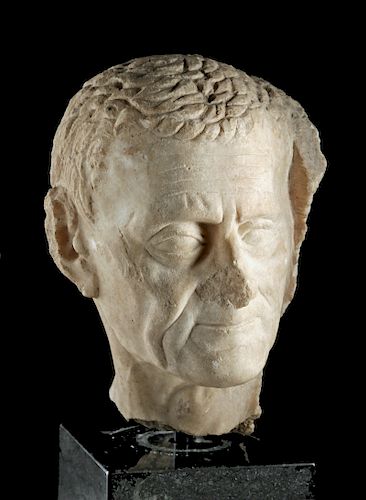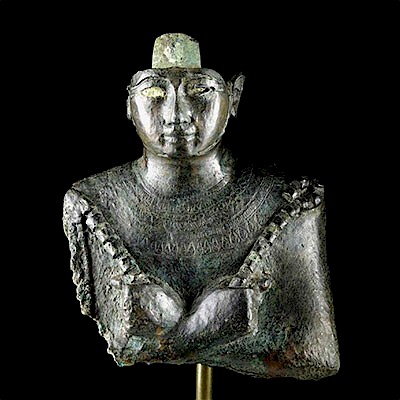Roman Marble Head of an Elderly Male
Lot 43
About Seller
Artemis Fine Arts
686 S Taylor Ave, Ste 106
Louisville, CO 80027
United States
Selling antiquities, ancient and ethnographic art online since 1993, Artemis Gallery specializes in Classical Antiquities (Egyptian, Greek, Roman, Near Eastern), Asian, Pre-Columbian, African / Tribal / Oceanographic art. Our extensive inventory includes pottery, stone, metal, wood, glass and textil...Read more
Estimate:
$20,000 - $30,000
Absentee vs Live bid
Two ways to bid:
- Leave a max absentee bid and the platform will bid on your behalf up to your maximum bid during the live auction.
- Bid live during the auction and your bids will be submitted real-time to the auctioneer.
Bid Increments
| Price | Bid Increment |
|---|---|
| $0 | $25 |
| $300 | $50 |
| $1,000 | $100 |
| $2,000 | $250 |
| $5,000 | $500 |
| $10,000 | $1,000 |
| $20,000 | $2,500 |
| $50,000 | $5,000 |
| $100,000 | $10,000 |
| $200,000 | $20,000 |
About Auction
By Artemis Fine Arts
May 22, 2019
Set Reminder
2019-05-22 10:00:00
2019-05-22 10:00:00
America/New_York
Bidsquare
Bidsquare : Exceptional Day 1: Antiquities Asian Fine Art
https://www.bidsquare.com/auctions/artemis-gallery/exceptional-day-1-antiquities-asian-fine-art-4129
Day 1 of an important 2-day auction featuring exceptional art from around the world - Egyptian, Greek, Etruscan, Roman, Viking, Russian, Near Eastern; Asian Art from China, Japan, Thailand, Vietnam, Burma, India; Fine Art from the 17th century to present. Artemis Fine Arts info@artemisfinearts.com
Day 1 of an important 2-day auction featuring exceptional art from around the world - Egyptian, Greek, Etruscan, Roman, Viking, Russian, Near Eastern; Asian Art from China, Japan, Thailand, Vietnam, Burma, India; Fine Art from the 17th century to present. Artemis Fine Arts info@artemisfinearts.com
- Lot Description
Roman, Republican Period, ca. late 1st century BCE. A marble head of an elderly man from a relief - similar to Republican portraits of Julius Caesar found on coinage of the state (the Roman Senate made Caesar the first living Roman whose image was portrayed on state coinage in 44 BCE). Note his clean-shaven haggard visage, wrinkles upon his forehead, folded baggy skin on this neck, and a receding hairline with closely cropped hair that is combed forward from the crown of his head and finely delineated with incised wavy locks. The veristic rendering of his visage is a product of keen observation on the part of the sculptor. Note the furrows across his forehead, those deep-set, large, almond-shaped eyes beneath full brows, his pursed thin lips flanked by nasolabial creases, and overall gaunt face with pronounced cheek bones and pointy chin. Further conveying his advanced age are the wrinkles surrounding the Adam's apple on his neck. The epitome of Republican "warts and all" portraiture! Size: 10" H (25.4 cm); 16.25" H (41.3 cm) on included custom stand.
This remarkably realistic representation suggests that the portrait may have been created during his lifetime or very soon after death, perhaps taken from a death mask. The sculptors' "warts and all" approach which may seem unflattering to modern eyes, was extremely popular during the late Republic and Early Empire periods. Such realistic portraits were created to preserve records of elite members of society such as senators, generals, and other high-ranking officials.
In the Classical world, portraiture served two main functions - all depended upon whether the subject was dead or alive. Images of the deceased were created for ancestral worship and kept in a private or family context. Ancestral busts preserved the individual's contributions and legitimized the family line. Sometimes masks of important ancestors were worn at funeral processions. Images of the living, on the other hand, were placed in public contexts, as a means of commemorating the individual's might, oftentimes honoring a military victory or public benefaction. For example, sculptures of Augustus and successive emperors served to advertise and affirm their power.
Cf. a similar sized portrait of an old man from a tomb relief, said to be from Rome, now in the Metropolitan Museum, inventory number 17.230.133.
A portrait bust depicting Julius Caesar that is very similar in style and likeness to this example hammered at 160,000 Euro at Gorny & Mosch (June 2014) - https://www.gmcoinart.de/auction/STEINSKULPTUR_Portr%C3%A4t%20des%20Gaius%20Julius%20Caesar.aspx?los=10&lager=00108&ActiveID=106&lang=en
The description translates as follows: "In 44 BC. the Roman Senate voted to make Caesar the first living Roman to be portrayed on the coinage of the state. Immediately, the Roman mint began to churn out money with variations on the new theme, the dictators portrait. Nevertheless the research seems to be still quite diffuse as an official effigy was not published during his lifetime. The portraits that appear on republican coins can be referred for comparison, although they show great individuality of features. But despite all differences they have three important characteristics in common: They show Caesars head in profile right, a haggard face with wrinkled forehead, prominent nose and a long narrow neck with folds of baggy skin. This is exactly what Suetonius relates (Divus Iulius, Cap. 45):while his baldness was a disfigurement which troubled him greatly, since he found that it was often the subject of the gibes of his detractors. Because of it he used to comb forward his scanty locks from the crown of his head . The present marble head reflects the high cheekbones with the sunken cheeks, the aquiline nose, the broad mouth and the individual wrinkled skin of the neck. All of these features are comparably found in authenticated portraits as well (cf. E. Boehringer, Der Caesar von Acireale [1933] Taf. 25-29). Exactly for these reasons the designation of this portrait head as Gaius Iulius Caesar appears to be secured. As it bears all the characteristics of republican portrait art it must have been created during the dictators lifetime or very soon after his death. It originates presumably from a statue. Especially in Asia Minor Caesar gained great popularity by freeing the cities from the Roman tax collectors excessive demands as well as by granting privileges to the leading municipalities. The cities repaid the Clementia Caesaris with the erection of statues and other honours (cf. K. Tuchelt, Frühe Denkmäler Roms in Kleinasien 1: Roma und Romagistrate [1979] Nr. 45-54; statues in Alabanda, Ephesos, Pergamon, Phokaia and Smyrna). In most cases the only reminders of them are the inscriptions on their bases whilst the presevation of a head like this one is a very rare exception."
Provenance: private East Coast, USA collection; ex-William Froelich collection, New York, USA, acquired in the 1970s
All items legal to buy/sell under U.S. Statute covering cultural patrimony Code 2600, CHAPTER 14, and are guaranteed to be as described or your money back.
A Certificate of Authenticity will accompany all winning bids.
We ship worldwide and handle all shipping in-house for your convenience.
#144095Losses to back, sides, neck, and high-pointed areas such as the nose and ears as shown. Expected surface wear commensurate with age, though the visage is still quite strong with realistic features and countenance.Condition
- Shipping Info
-
All shipping is handled in-house for your convenience. Your invoice from Artemis Gallery will include shipping calculation instructions. If in doubt, please inquire BEFORE bidding for estimated shipping costs for individual items.
-
- Buyer's Premium



 EUR
EUR CAD
CAD AUD
AUD GBP
GBP MXN
MXN HKD
HKD CNY
CNY MYR
MYR SEK
SEK SGD
SGD CHF
CHF THB
THB














